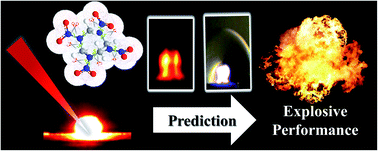Fast explosive performance prediction via small-dose energetic materials based on time-resolved imaging combined with machine learning†
Abstract
Fast, reproducible, and quantitative performance evaluation of monomolecular energetic materials (EMs) is a significant challenge that limits the tailored applications of EMs and the development of new high-energy-density materials. Here, a small-dose-based alternative method for the detection of the detonation velocity (DV), heat of detonation (HoD), volume of detonation (VoD), detonation pressure (DP), and detonation temperature (DT) from laser-induced shock-wave images combined with a machine learning algorithm is proposed. On the basis of a comprehensive investigation of the time-resolved plume dynamic behavior and spectral emission properties, we concluded that the exothermic chemical reaction associated with detonation occurred at about 25 μs after the laser pulse termination. Moreover, 27 types of explosives were tested to build the prediction model to validate the proposed theory. Our model accurately predicted the explosion parameters with an average relative error of test set (ARETe) of the models for the DV, VoD, and DT of <5%. In particular, the maximum relative error of test set (MRETe) of the quantitative analysis model for the DV and VoD was less than 4%. Our results demonstrate the value of laser-based micro-explosion technology in an explosion testing system and provide an analytic means for estimation of the detonation performance of EMs in a high-speed, less-consumption, low-cost, high-precision, and practical way.



 Please wait while we load your content...
Please wait while we load your content...